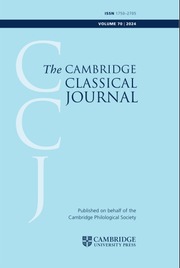Article contents
THE VIEW FROM THE MOUNTAIN (OROSKOPIA) IN GREEK AND LATIN LITERATURE
Published online by Cambridge University Press: 18 April 2018
Abstract
This paper argues for the existence of the topos of oroskopia in Greek and Latin literature. Gods and mortals are positioned on mountains to watch events or landscapes below. The view from above symbolises power (in the case of the gods) or an attempt at control or desire for power (in the case of mortals). It may also suggest an agreeable and relaxed spectatorship with no active involvement in the events watched, which may metaphorically morph into a historian's objectivity or a philosopher's emotional tranquillity. The elevated position may also have a temporal aspect, gods looking into the future or mortals looking back on their life.
- Type
- Research Article
- Information
- Copyright
- Copyright © The Author(s) 2018. Published by Cambridge University Press
References
Works cited
- 4
- Cited by


